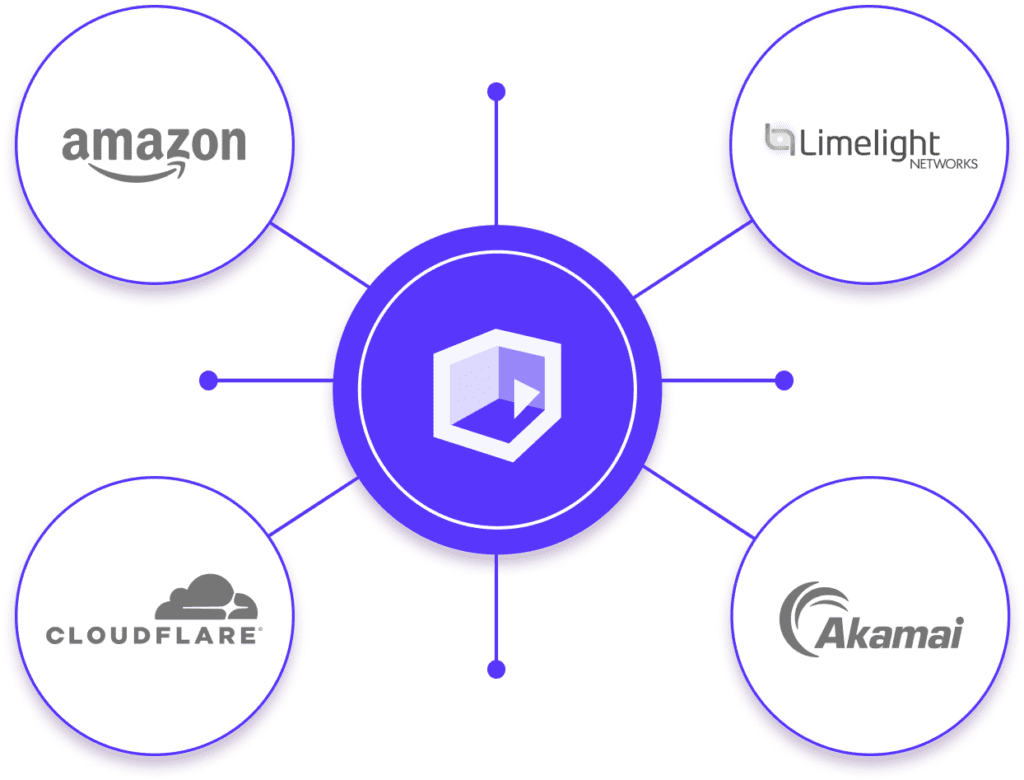What is a CDN? A Beginner’s Guide to Content Delivery Networks
Industry Insights
Updated on February 14, 2025
Website performance is a critical factor that can make or break e-commerce success. Content delivery networks (CDNs for short) are the unsung heroes that provide the infrastructure necessary for rapid media delivery.
For e-commerce professionals wondering, “What is a CDN?”—this comprehensive guide provides a high-level look at content delivery networks and their significance, functionality, and impact on marketing.
What is a CDN: An In-Depth Definition
A content delivery network is a sophisticated IT infrastructure that optimises website performance by efficiently delivering digital content to users. As a network of strategically placed servers, CDNs minimise latency, expedite content delivery, and improve the user experience.
CDNs distribute static and dynamic content, such as images, videos, stylesheets, and scripts. It enables content to be stored closer to end-users, and minimizes the physical distance data must travel, and consequently, improving loading times.
How CDNs Work
CDNs replicate content across various geographically dispersed servers. When a user requests a piece of content, the CDN identifies the server closest to them and delivers the content from that server. This process achieves faster loading times and a smoother experience.
CDN Hosting
CDN hosting is an important part of website optimisation. Through CDN hosting services, online retailers distribute the load of content delivery across multiple servers and prevent any single server from becoming a bottleneck.
This not only improves website performance but also ensures stability during peak traffic periods.
Load Balancing
Traffic fluctuations are inevitable. CDNs act as a strategic SEO ally through intelligent load-balancing mechanisms. Incoming traffic is distributed across multiple servers, which prevents any single server from excessive load.
This not only safeguards against server overload but also ensures consistent performance, irrespective of the volume of incoming requests. Load balancing maintains a responsive and reliable online presence, a prerequisite for any eCommerce business interested in success.
Latency Reduction
In the attention economy, every second counts. CDNs address this by minimising latency, which is the time it takes for data to travel from server to user.
The strategic placement of servers close to end-users means CDNs reduce the physical distance data must traverse. This results in significantly faster page load times, creating a seamless and engaging user experience.
As eCommerce professionals strive to capture and retain customer attention, the latency reduction offered by CDNs becomes a game-changer for website performance.
Bandwidth Optimisation
Efficient bandwidth usage is a cornerstone of prudent resource management for eCommerce professionals. CDNs optimise bandwidth usage by intelligently managing the distribution of content.
This not only leads to significant cost savings but also contributes to improved overall performance. Through streamlined delivery of images, videos, stylesheets, and scripts, CDNs ensure efficient deployment of resources.
This is particularly vital for e-commerce businesses seeking to balance the delivery of rich content with cost-effective operations.
The Types of CDNs
There are various types of CDNs, each catering to specific needs and preferences. Each type is crafted to cater to unique needs and preferences, ensuring that businesses can align their CDN strategy with their specific objectives.
Here, we shed light on some characteristics of common CDN types and explain the functionalities of each.

Cloud-Based CDNs
Cloud-based CDNs, so named because they use cloud infrastructure, are the most prevalent type of CDN. This approach offers scalability and flexibility, allowing businesses to adapt to fluctuating demands.
Cloud-based CDNs dynamically allocate resources based on real-time requirements, which achieves optimal performance even during traffic spikes. The agility provided by cloud-based CDNs is invaluable for businesses seeking a robust content delivery solution.
Media CDNs
Media CDNs specialise in the delivery of media content, such as videos and audio files. Built as an answer to unique challenges posed by rich media, these CDNs optimise their infrastructure to ensure swift and efficient delivery.
Whether it’s streaming high-definition videos or providing seamless audio playback, media CDNs are engineered to meet the specific demands of multimedia content. Their roles have become more pronounced in e-commerce as businesses increasingly incorporate multimedia into their strategies.
Global CDNs
In a world where online audiences span continents, global CDNs have become more significant. This type of network provides widespread coverage and optimal performance for users regardless of their geographical location.
Global CDN providers minimise latency and data travel time by placing servers in various regions, delivering content with remarkable speed. This global reach is particularly crucial for e-commerce businesses with an international footprint, and provide consistent experiences to users worldwide.
Specialised CDNs
Specialised CDNs apply the same principles and techniques but for specific types of content. Here are some examples of specialised CDNs:
- Image CDNs
- Video CDNs
- E-Commerce CDNs
- Dynamic Content CDNs
- API CDNs
The Benefits of CDNs
Content delivery networks provide several advantages that directly impact website performance and user experience. For anyone involved in marketing, IT, or business development at firms reliant upon digital B2C sales, knowledge of the key benefits of CDNs is important to say ahead.
Accelerated Content Delivery
The heartbeat of any e-commerce website lies in the speed at which content is delivered to users. CDNs function as accelerators, ensuring the rapid delivery of content and significantly reducing load times.
For e-commerce companies, these web content accelerators are strategic advantages in a world where every second counts.
Secure Content Delivery
With cyber threats and data breaches on the rise, a secure online environment is non-negotiable. CDNs play the role of digital guardians by implementing SSL/TLS encryption.
SSL/TLS encryptions establish a secure connection between users and the website, safeguarding sensitive information such as personal details, payment data, and login credentials.
For companies dependent upon customer trust, secure content delivery is not just a feature—it’s a fundamental assurance of a safe and reliable online shopping experience.
Meeting Real-Time User Demands
The preferences and expectations of online users are dynamic and require a responsive and adaptable content delivery approach. CDNs rise to this challenge by offering dynamic content delivery, tailoring the presentation of content based on the user’s location and preferences.
Whether it’s adjusting image resolutions, serving region-specific promotions, or optimising video quality, CDNs adapt content in real-time and help create personalised, user-centric experiences. This is known as dynamic content delivery.
CDN Costs
While the benefits of CDNs are undeniable, e-commerce marketers need to know the associated costs. CDN pricing models vary, and factors such as data transfer, storage, and additional features contribute to the overall expenses.
The investment in these platforms is often justified by a potential increase in conversions and improved user experience. Google states that the probability of bounce increases by 32% as page load time goes from one to three seconds.
The Future of CDNs
As technology advances, CDNs continue to shape online customer experiences. Technologies like edge computing, improved security measures, and advancements in content acceleration techniques are poised to redefine content delivery.
The integration of AI and machine learning will further optimise content distribution. These networks are set to become even more indispensable as businesses cater to a growing global audience.
CDNs as a Component of DAM
CDNs serve as indispensable components within Digital Asset Management (DAM) frameworks, optimising media asset delivery. This integration lets you distribute content even faster.
When you integrate CDN functions as part of your DAM, you can store, manage, and publish your files from a single location.
Introducing DemoUp Cliplister’s Multi-CDN
DemoUp Cliplister offers a powerful multi-CDN as part of its product range for reliable content delivery. Why choose one network, when you can have several?
Equipped with technology from leading CDN companies like Cloudflare, Akamai, Amazon CloudFront, and Limelight Networks, our solution powers some of the biggest e-commerce players in the world. Fill out the form below to learn how it can power your business too.
Wrapping Up
In summary, CDNs are pivotal for e-commerce companies in several undeniable ways. With the ability to optimise bandwidth, shrink page load times, fortify cybersecurity, and provide strategic benefits, CDNs are a major key to shopper satisfaction.
As business turns toward the era of artificial intelligence, the significance of CDNs will continue to grow. Will you stay ahead of the competition?
Frequently Asked Questions
A CDN, or Content Delivery Network, optimises web content delivery by strategically placing servers worldwide. It reduces latency, accelerates loading times, and enhances overall user experience for websites and applications.
CDNs enhance website speed, especially in media-rich content, by distributing images, videos, and other media assets strategically. This minimises latency, accelerates loading, and ensures an optimised and engaging user experience.
Yes, a CDN includes caching as a key feature. It strategically stores content on distributed servers, reducing latency by serving cached content to users based on their geographical proximity.
Normally, to use a CDN on your website, you sign up with a CDN provider, configure your settings, and integrate the CDN into your site. This involves DNS changes and content optimisation for efficient delivery. However, DemoUp Cliplister’s dynamic image delivery seamlessly integrates with e-commerce platforms to provide an easier way by allowing you to optimize visual media at scale.
CDNs enhance the online shopping experience by optimising website performance. They reduce page load times, ensuring swift access to product pages and images, leading to a seamless and engaging shopping journey.
Better Content. More Sales.

Fill out the form to discover our end-to-end eCommerce content solutions for brands & shops




